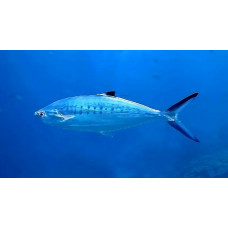Latin name
Scomberoides lysan
Other name
Giant dart, large-mouthed leatherskin, leatherskin, queenfish, skinny fish, skinnyfish, St. Peter's leatherskin, white fish or whitefish.
Identification
The body of the Doublespotted Queenfish is elongated, elliptical in shape, and strongly compressed at the sides. The upper and lower body profiles are similar in shape. The snout is pointed. The dorsal profile of the head is slightly convex. The upper lip is joined to the snout in the middle by a strip of skin (frenulum), separated by a shallow groove in juveniles. The tip of the upper jaw is vertical, passing through the posterior margin of the eye or slightly behind it. The first gill arch has 21-27 gill stamens (including rudimentary), of which 3-8 gill stamens on the upper part and 15-20 stamens on the lower part. The lateral line is slightly discontinuous, making a slight upward bend above the pectoral fins and then continuing straight to the base of the caudal fin. There are no bony flaps in the lateral line. The scales below the lateral line are lanceolate in shape, and partially depressed into the skin. There are no furrows on the caudal peduncle. Vertebrae: 10 vertebrae in the trunk and 6 in the tail.
Teeth
The teeth on the upper jaw are arranged in two rows: the outer row of enlarged teeth is conical, the inner row of teeth is tufted. The teeth on the lower jaw are arranged in two rows separated by a shallow groove; in adults, the teeth in the outer and inner rows are of equal size; in juveniles, the teeth in the outer row are more numerous and closer together than those in the inner row. Juveniles have one or two pairs of fang-like teeth on the symphysis of the lower jaw, which disappear as the fish grows. There are tufted teeth on the scutellum and palate.
Features of fish fins
The two dorsal fins are separated by a small gap. The first dorsal fin has 6-7 short, separate barbs arranged in a shallow groove. The second dorsal fin has one hard and 19-21 soft rays. The anal fin has two separate barbs and 17-19 soft rays. In the posterior parts of the soft dorsal and anal fins, the rays are connected by a membrane only to the middle of the ray. The bases of the second dorsal and anal fins are equal in length. The anterior lobes of the second dorsal and anal fins are elongated. The length of the pelvic fins is similar to that of the pectoral fins. The caudal fin is strongly serrate.
Fish colouring
The body of the double-spotted queenfish is grey-green above, becoming silvery-grey towards the midline, and silvery white below. Adults have 6-8 dark rounded spots on the sides of the body above and below the lateral line, sometimes joined by a narrow isthmus. In juveniles the spots are faint or absent. The distal half of the anterior lobe of the dorsal fin is heavily pigmented. The anterior lobe of the anal fin is white or pale yellow; often the membranes of several anterior rays are black, especially in large individuals.
Distribution
Widespread in the Indo-Pacific region from South Africa to the Red Sea and Persian Gulf; east along the coast of South and Southeast Asia to Indonesia and Papua New Guinea; north to southern Japan and the Ryukyu Islands; south to Western Australia and New South Wales. The only member of the genus found in the central Pacific Ocean: Rapa-Iti (French Polynesia), Marquesas Islands, Tonga, Hawaiian Islands.
Habitat
Marine pelagic fish. They live in coastal waters in shallow lagoons, near reefs and oceanic islands at depths of 1-100 metres.
Size
The maximum body length of these fish is 110 cm, usually up to 60 cm. The body weight is up to 11 kg.
Behavior
They are solitary, sometimes forming small schools. Found only in relatively clear waters, adults in clear lagoons and coastal reefs, juveniles in shallow waters near the shore and in brackish waters.
Food and feeding habits
Feeds on fish and crustaceans during the day. Juveniles feed on the scales and epidermis of other fish.
Reproduction
Off the coast of Sri Lanka, males mature to a length of 55-60 cm and females mature to a length of 60-65 cm. They spawn in June and September. Absolute fecundity ranges from 24.66 (female body length 58.5 cm) to 8356 (female body length 74.3 cm) thousand eggs.
Fishing
The species is of limited local commercial importance. It is a popular sport fishing target.
Relationship with a person
As in other members of the genus Scomberoides, the barbed rays of the first dorsal and anal fins are associated with venom glands; their sting can be quite painful to humans.
| Classification | |
| Phylum | Chordata |
| Class | Actinopterygii |
| Squad | Carangiformes |
| Family | Carangidae |
| Genus | Scomberoides |
| Species | S. lysan |
| Features | |
| Conservation status | Least Concern |
| Habitat | Pelagic |
| Life span, years | No information |
| Maximum body weight, kg | 11 |
| Maximum length, cm | 110 |
| Sailing speed, m/s | No information |
| Threat to people | Not edible |
| Way of eating | Predator |
Doublespotted queenfish
Tags: doublespotted queenfish



